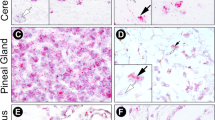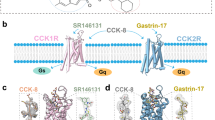Abstract
RECENT reports have shown that the brain contains an endogenous peptide with opiate-like activity1–3 and similar peptides have been found in the pituitary4,5,13. One of the brain peptides, known as methionine enkephalin, was identified as a pentapeptide Tyr–Gly–Gly–Phe–Met6, and evidence was presented that a minor component may have leucine in place of methionine. The principal sequence is identical to that at the NH2-terminus of lipotropin C fragment, a peptide discovered in substantial quantity in porcine pituitary7,8. This suggests that methionine enkephalin is derived in vio by proteolytic cleavage of C fragment. Since enkephalin is thought to compete directly with opiates for the brain opiate receptor, while having no primary structure similarity to opiates, we have searched for and found a basis for the competition in a proposed secondary structure for the peptide.
This is a preview of subscription content, access via your institution
Access options
Subscribe to this journal
Receive 51 print issues and online access
$199.00 per year
only $3.90 per issue
Buy this article
- Purchase on Springer Link
- Instant access to full article PDF
Prices may be subject to local taxes which are calculated during checkout
Similar content being viewed by others
References
Terenius, L., and Wahlström, A., Life Sci., 16, 1759–1764 (1975).
Hughes, J., Brain Res., 88, 295 (1975).
Pasternak, G. W., Goodman, R., and Snyder, S. H., Life Sci., 16, 1765–1769 (1975).
Teschemacher, H., Opheim, K. E., Cox, B. M., and Goldstein, A., Life Sci., 16, 1771–1776 (1975).
Cox, B. M., Opheim, K. E., Teschemacher, H., and Goldstein, A., Life Sci., 16, 1777–1782 (1975).
Hughes, J., et al., Nature, 258, 577–579 (1975).
Bradbury, A. F., Smyth, D. G., and Snell, C. R., in Peptides: Chemistry, Structure and Biology (edit. by Meienhofer, J.) (Ann Arbor Science Inc., in the press).
Bradbury, A. F., Smyth, D. G., and Snell, C. R., in The Polypeptide Hormones: Molecular and Cellular Aspects, Ciba Foundation Symp. No. 41 (edit. by Fitzsimons, D. W.), 61–69 (Associated Scientific, 1976).
Chou, P. Y., and Fasman, G. D., Biochemistry, 13, 211–222 (1974).
Chou, P. Y., and Fasman, G. D., Biochemistry, 13, 222–245 (1974).
Lewis, P. N., Momany, F. A., and Scheraga, H. A., Proc. natn. Acad. Sci. U.S.A., 68, 2293–2297 (1971).
Doré, C. F., Educ. Chem., 7, 194–195 (1970).
Bradbury, A. F., Smyth, D. G., Snell, C. R., Birdsall, N. J. M., and Hulme, E. C., Nature (in the press).
Author information
Authors and Affiliations
Rights and permissions
About this article
Cite this article
BRADBURY, A., SMYTH, D. & SNELL, C. Biosynthetic origin and receptor conformation of methionine enkephalin. Nature 260, 165–166 (1976). https://doi.org/10.1038/260165a0
Received:
Accepted:
Issue Date:
DOI: https://doi.org/10.1038/260165a0
This article is cited by
-
Endogenous Signaling Complexity in Neuropeptides- Leucine- and Methionine-Enkephalin
Cellular and Molecular Neurobiology (2006)
-
Comparison of cyclic ?-opioid peptides with non-peptide ?-agonist spiroindanyloxymorphone (SIOM) using the message-address concept: A molecular modeling study
Journal of Computer-Aided Molecular Design (1996)
-
Characterization of low-energy conformational domains for Met-enkephalin
Journal of Computer-Aided Molecular Design (1992)
-
A proposal for the molecular basis of ? and ? opiate receptor differentiation based on modeling of two types of cyclic enkephalins and a narcotic alkaloid
Journal of Computer-Aided Molecular Design (1991)
-
Crystal structure of leucine-enkephalin
Nature (1983)
Comments
By submitting a comment you agree to abide by our Terms and Community Guidelines. If you find something abusive or that does not comply with our terms or guidelines please flag it as inappropriate.



